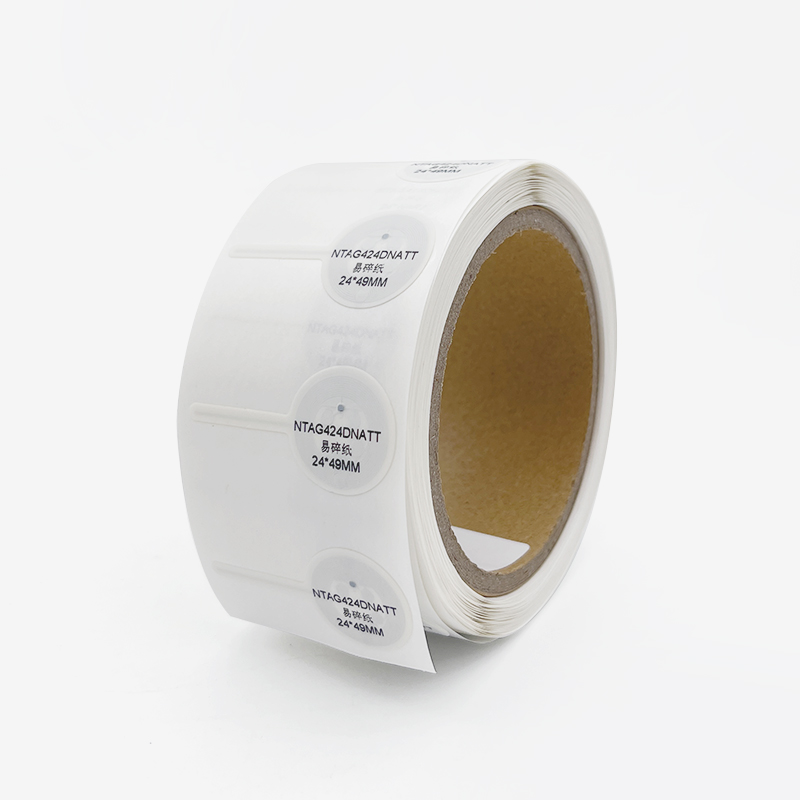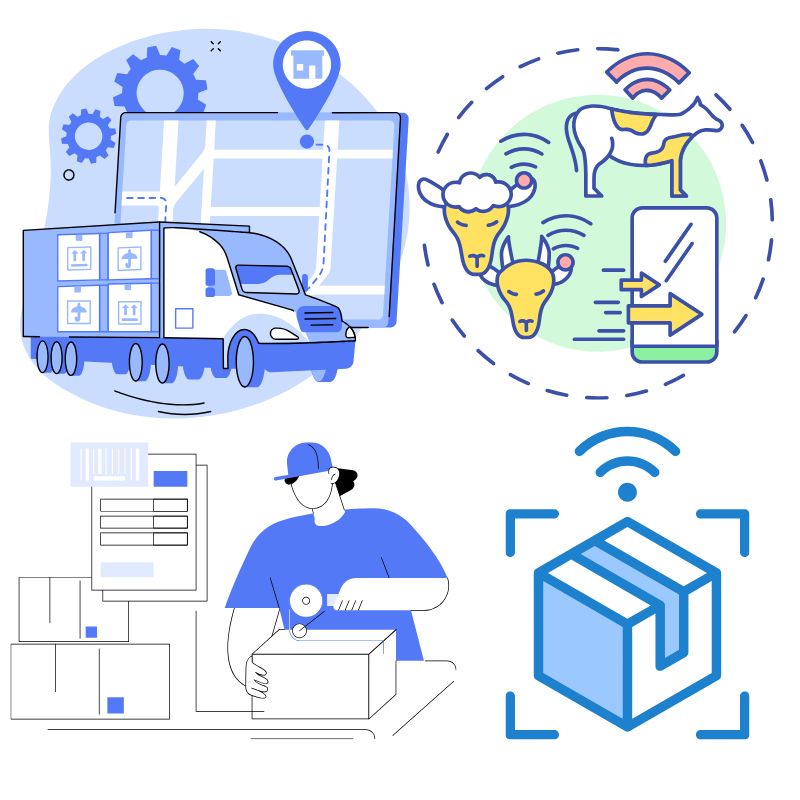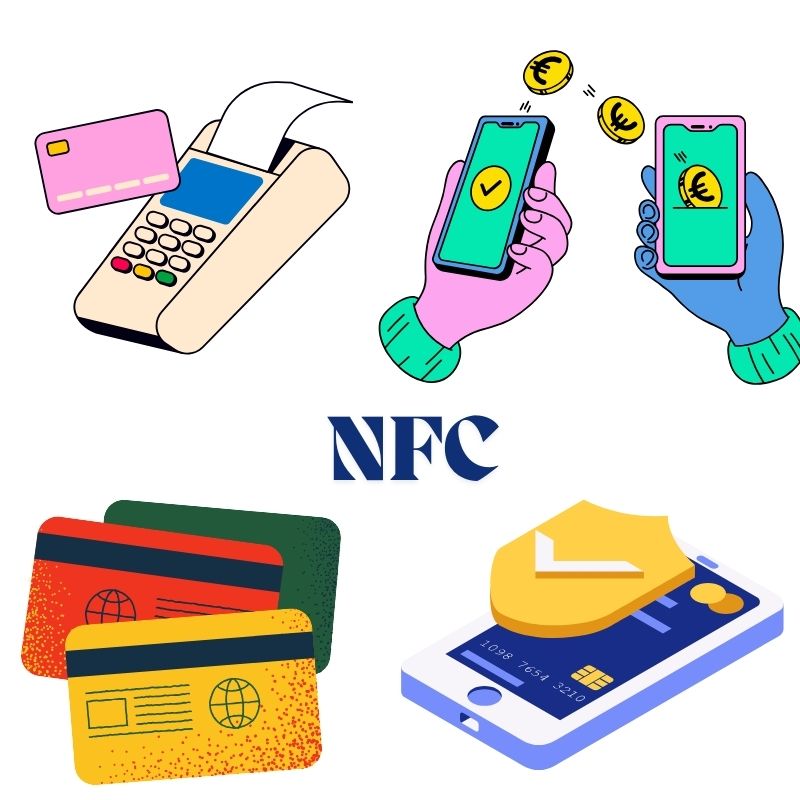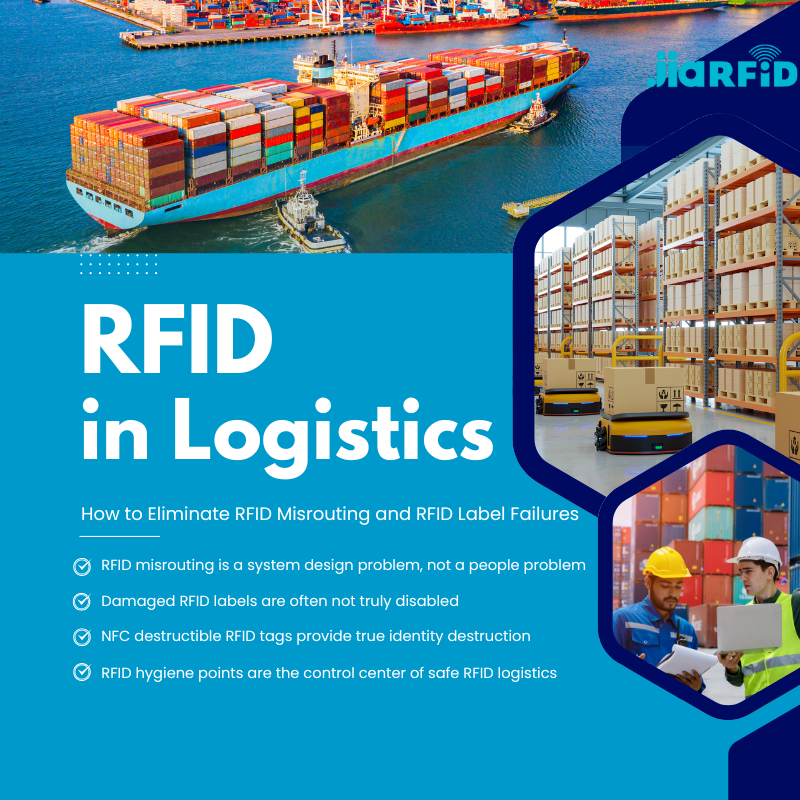
Kakšna je razlika med NFC in RFID?
Kazalo
NFC in RFID: ključne razlike, uporaba in izbira (vodnik za leto 2025)
Od sledenja zalog do brezstičnih plačil – te brezžične komunikacijske metode pomagajo industriji avtomatizirati procese, zmanjšati napake in izboljšati varnost.
Ta vodnik razlaga razliko med RFID in NFC, kako delujeta, njune uporabe in katera od njiju najbolj ustreza vašim potrebam v letu 2025.

Kaj sta RFID in NFC?
RFID (radiofrekvenčna identifikacija)
RFID uporablja radijske valove za samodejno prepoznavanje in sledenje predmetov prek RFID-oznak in RFID-bralnikov. Pogosto se uporablja v različnih panogah, kot so logistika, trgovina na drobno, proizvodnja in zdravstvo, za sledenje sredstev in poenostavitev poslovanja v dobavni verigi.
- Frekvenčni pasovi: nizki (LF), visoki (HF) in ultra visoki (UHF)
- Doseg branja: do 100 metrov (aktivne oznake)
- Oznake: Pasivni (brez baterije) ali aktivni (na baterije)
- Primeri uporabe: Upravljanje zalog, sledenje sredstev, nadzor dostopa
NFC (komunikacija na kratko razdaljo)
NFC je specializirana podskupina RFID, ki deluje na frekvenci 13,56 MHz (HF). Za razliko od splošnega RFID, NFC omogoča dvosmerno komunikacijo med napravami na zelo kratki razdalji – običajno manj kot 4 cm. Široko se uporablja za varno in hitro izmenjavo podatkov, na primer za mobilna plačila ali digitalne vizitke.
- Frekvenčni pas: visoka frekvenca (13,56 MHz)
- Razpon: v nekaj centimetrih
- Interaktivnost: Podpira dvosmerno komunikacijo
- Primeri uporabe: Brezkontaktno plačevanje, povezovanje pametnih telefonov, javni prevoz
NFC proti RFID: kakšna je razlika?
Razlika med RFID in NFC je v dosegu, interaktivnosti, moči in uporabi. Tukaj je hitra primerjalna tabela:
| Funkcija | RFID | NFC |
|---|---|---|
| Frekvenčni pas | LF, HF, UHF | HF (13,56 MHz) |
| Preberi obseg | Do 100 metrov | Znotraj nekaj centimetrov |
| Komunikacija | Enosmerno (večinoma) | Dvosmerno |
| Vir napajanja | Pasivno ali aktivno | Tipično pasivno |
| Aplikacije | Zaloge, dobavna veriga, nadzor dostopa | Mobilna plačila, izmenjava podatkov |
| Interaktivnost | Nizka | Visoka (interakcija med uporabnikom in napravo) |
- “RFID je idealen za sledenje sredstev v velikem obsegu, medtem ko je NFC zasnovan za varne interakcije na kratke razdalje, kot so mobilna plačila.”
Kako deluje tehnologija RFID
RFID sistem temelji na treh osnovnih komponentah:
- RFID oznake: Shranjujejo informacije o artiklu (lahko so samo za branje ali za branje/pisanje).
- RFID čitalnik: oddaja signal za napajanje pasivnih oznak in pridobivanje podatkov.
- Programski sistem: interpretira in upravlja zbrane podatke.
Vrste oznak RFID
- Pasivne RFID oznake: brez notranje baterije, napajajo jih signali RFID čitalnika.
- Aktivne RFID oznake: Imajo lasten vir napajanja za večji doseg in pogoste posodobitve podatkov.
RFID in NFC čitalniki so na voljo v ročni in fiksni obliki, odvisno od namena uporabe.
Kako deluje NFC
Tehnologija NFC omogoča komunikacijo na kratko razdaljo med dvema napravama, ki podpirata NFC, ali med napravo in oznako NFC.
Prednosti NFC:
- Enostavnost Tap-and-Go: ni potrebno povezovanje ali skeniranje.
- Visoka varnost: Idealno za brezstične finančne transakcije.
- Dvosmerna komunikacija: Za razliko od večine RFID sistemov lahko podatki tečejo v obe smeri.
Naprave NFC in RFID Reader se vse bolj vgrajujejo v pametne telefone, POS terminale in prehodne vratce za hitre, zanesljive in varne interakcije.
Aplikacije RFID
RFID in NFC omogočata raznolike aplikacije, vendar sta zaradi velikega dosega in prilagodljivosti RFID idealna za:
Upravljanje zalog
- Posodobitve v realnem času
- Avtomatsko sledenje po skladiščih
Sledenje sredstvi
- Nadzorujte medicinsko opremo, orodje ali vozila
- Povečajte učinkovitost v logistiki in zdravstvu
Nadzor dostopa
- Uporabite RFID ključne kartice, obeske ali izkaznice
- Nadzor dostopa do varnih stavb ali območij
Aplikacije NFC
Varnostne funkcije in kratki doseg tehnologije NFC se odlično izkažejo v osebnih in javnih aplikacijah:
Mobilna plačila
- Apple Pay, Google Pay, Samsung Pay.
- Varne transakcije v nekaj sekundah.
Pametne naprave in trženje
- Tapnite, da zaženete aplikacije ali delite kontaktne podatke.
- Pametne oznake za informacije o izdelku ali prijave.
Transportni sistemi
- Brezstične prevozne kartice.
- Enostavno vkrcanje v podzemno železnico in avtobusno omrežje.

NFC ali RFID: katero naj uporabite?
| Primer uporabe | Najboljša tehnologija |
|---|---|
| Sledenje na velike razdalje | RFID |
| Zaloge ali operacije v dobavni verigi | RFID |
| Varne, osebne transakcije | NFC |
| Mobilna plačila in identifikacija | NFC |
| Pametna avtomatizacija IoT | Oba |
Če upravljate s tisočimi sredstvi, je RFID prava izbira za vas. Za posamezne, varne interakcije, kot je dotik telefona, je NFC jasna izbira.
NFC in RFID v IoT (internet stvari)
RFID in NFC sta temeljna za ekosisteme IoT, saj omogočata fizičnim predmetom, da “komunicirajo” z digitalnimi sistemi.
- RFID v internetu stvari (IoT): Nadzoruje blago v dobavnih verigah in proizvodnih obratih.
- NFC v internetu stvari: Omogoča varno povezovanje naprav, dostop do pametnega doma in nadzor v realnem času prek pametnih telefonov.
“Kombinacija NFC in RFID oznak spreminja IoT, saj povezuje fizična sredstva z oblakom.”
Vloga frekvence v delovanju NFC in RFID
Razumevanje frekvence pomaga pri izbiri pravega sistema:
- LF (125–134 kHz) – Kratek doseg, uporablja se za nadzor dostopa
- HF (13,56 MHz) – Uporablja se tako za RFID kot za NFC
- UHF (860-960 MHz) – Dolgi doseg, idealen za dobavne verige
Vsaka frekvenca podpira različne razpone in hitrosti branja, zato je izbira RFID- in NFC-bralnika pomembna za delovanje sistema.
Pogosta vprašanja o NFC in RFID
Kakšna je glavna razlika med RFID in NFC?
NFC je podskupina RFID. Medtem ko RFID podpira daljši doseg in enosmerno komunikacijo, je NFC zasnovan za dvosmerne interakcije na kratki razdalji.
Ali se lahko oznake NFC in RFID uporabljajo medsebojno zamenljivo?
Ne vedno. NFC deluje samo na HF, medtem ko RFID lahko uporablja LF, HF ali UHF. NFC oznake delujejo samo z NFC čitalniki, ne pa z vsemi RFID čitalniki.
Ali so oznake RFID varne?
Pasivne RFID-oznake so brez šifriranja lahko ranljive. NFC ponuja več vgrajene varnosti, zlasti za finančne transakcije.
Kaj je NFC in RFID čitalnik?
To je naprava, ki se uporablja za branje RFID ali NFC oznak. Mnogi sodobni pametni telefoni delujejo kot NFC čitalniki za brezstične akcije.
Kako delujejo plačila z NFC?
Naprave uporabljajo NFC za brezžično pošiljanje šifriranih plačilnih podatkov na združljive terminale – fizični stik ni potreben.
Katera industrija ima največ koristi od RFID?
Trgovina na drobno, zdravstvo, logistika, proizvodnja in skladiščenje uporabljajo RFID za avtomatizacijo in preglednost.
Končne misli
Tako RFID kot NFC ponujata veliko prednosti – ne glede na to, ali sledite paletam ali plačujete s pametnim telefonom. Vaša izbira mora biti skladna z vašimi operativnimi potrebami:
- Za široko, avtomatizirano sledenje izberite RFID.
- Za varne interakcije na kratko razdaljo izberite NFC.
Ker se RFID- in NFC-oznake razvijajo skupaj z IoT, je zdaj idealni čas, da jih vključite v svoj delovni tok.
Potrebujete pomoč pri izbiri pravega NFC ali RFID sistema za vaše podjetje?
Kontaktirajte nas danes ali si oglejte našo celotno ponudbo NFC in RFID čitalnikov in oznak.

Ray Zhou
Ta članek je napisal Ray Zhou, strokovnjak za tehnologijo RFID z več kot 10 leti izkušenj v industriji.
Komentarji
Vroči izdelki

RFID v logistiki: Kako odpraviti napačno usmerjanje RFID in napake RFID-oznak
RFID v logistiki je več kot le orodje za pospešitev procesov. Postal je ključni del delovanja sodobnih dobavnih verig.

Kaj je RFID upravljanje z odpadki
Predstavljajte si mesto, v katerem vsak smetnjak govori – ne dobesedno, ampak prek majhnega čipa, ki sistemu sporoči, kdaj je poln, kdaj je izpraznjen in kam je bil odpeljan. To je tisto, kar danes počne RFID upravljanje z odpadki.

Kaj so tesnila vijakov in njihova uporaba? | Celovit vodnik
V svetovni trgovini in logistiki imajo zaporne plombe ključno vlogo pri zagotavljanju varnosti in skladnosti tovora. Te majhne, a zmogljive naprave so namenjene zaklepanju ladijskih zabojnikov, prikolic in tovornih vrat z mehanizmom, ki preprečuje nedovoljeno spreminjanje.

Kaj je zaščita za kartice RFID? Prednosti, primeri uporabe in vodnik za nakup
Tehnologija RFID (radiofrekvenčna identifikacija) je povsod: na kreditnih karticah, osebnih izkaznicah, vozovnicah, ključih hotelskih sob in drugje. Omogoča hitrost in udobje, vendar odpira tudi vrata novi vrsti digitalne kraje, imenovani "skimming". Tu pride prav zaščita za kartice RFID.

Zapestnice RFID za dogodke: Priročnik za množično nakupovanje za organizatorje
Zapestnice RFID za prireditve postajajo rešitev za organizatorje, ki na koncertih, festivalih in športnih prizoriščih potrebujejo hitrejši vstop, preprečevanje goljufij in brezgotovinsko plačevanje. Za razliko od papirnatih vstopnic ali kod QR te pametne zapestnice uporabljajo vgrajene čipe za poenostavitev dostopa, zavarovanje transakcij in izboljšanje izkušnje gostov.

Kako oznaka RFID na vetrobranskem steklu izboljša nadzor dostopa vozil in sisteme cestninjenja
V današnjem hitrem svetu mora biti identifikacija vozila hitra, varna in brezstična. Oznaka RFID na vetrobranskem steklu zagotavlja prav to - zanesljiv način upravljanja cestninjenja, parkiranja in zaprtega dostopa brez ustavljanja vozil.
Oznake
POVEZANI BLOGI

RFID v logistiki: Kako odpraviti napačno usmerjanje RFID in napake RFID-oznak
RFID v logistiki je več kot le orodje za pospešitev procesov. Postal je ključni del delovanja sodobnih dobavnih verig.

Kaj je RFID upravljanje z odpadki
Predstavljajte si mesto, v katerem vsak smetnjak govori – ne dobesedno, ampak prek majhnega čipa, ki sistemu sporoči, kdaj je poln, kdaj je izpraznjen in kam je bil odpeljan. To je tisto, kar danes počne RFID upravljanje z odpadki.

Kaj so tesnila vijakov in njihova uporaba? | Celovit vodnik
V svetovni trgovini in logistiki imajo zaporne plombe ključno vlogo pri zagotavljanju varnosti in skladnosti tovora. Te majhne, a zmogljive naprave so namenjene zaklepanju ladijskih zabojnikov, prikolic in tovornih vrat z mehanizmom, ki preprečuje nedovoljeno spreminjanje.




